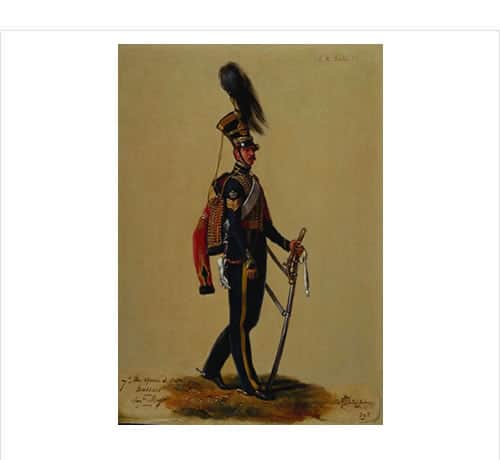Courtesy of The Royal Collection Trust
In 1832 French portraitist Alexandre-Jean Dubois Drahonet was commissioned by William IV to paint one hundred pictures illustrating the uniform of the British Army.
The Royal Collection retains most of this series. A photograph of the Equerry’s Room at Windsor Castle taken in around 1900 shows some of these paintings hanging together, framed in groups.
During the period of peace following the Napoleonic Wars, increasingly elaborate (and often quite impractical) military attire was devised, particularly by George IV.
By the time William IV came to the throne in 1830, uniforms had become too expensive and were simplified and adapted once again. The result of these changes was codified and promulgated in the 1831 Dress Regulations.
These paintings were intended to provide a visual record of the recent changes to the military dress.
Their value is not only historical, however, but also aesthetic: Drahonet produces lively, slightly elongated figures, capturing their facial expressions and setting them in a variety of organic poses.
Each painting in the series depicts a single figure against a neutral background. Although their uniform and accoutrements are the focus, the sitters are often identified by name, as well as regiment and rank. Shown here is Regimental Sergeant-Major William Franklin of the 7th (Queen’s Own) Hussars.
The Hussars were a regiment of light cavalry mounted on particularly fast horses, used in skirmishes and for reconnaissance duties. Taking their name and function from Hungarian cavalry forces, the British Army’s Hussars developed out of Light Dragoon regiments from the beginning of the 19th century.
Franklin, shown in the profile, models many key aspects of the newly updated Hussar uniform. While both the coatee and trousers of the 7th Hussars remained dark blue, the pelisse (worn slung over the shoulder) was now red, following William IV’s preference for the colour.
Where earlier in the century the Hussars had worn a fur cap, all regiments had by now adopted the shako, modelled on that of the Light Dragoons, but decorated with a cartwheel symbol rather than a Maltese cross and topped by a black rather than white plume.


